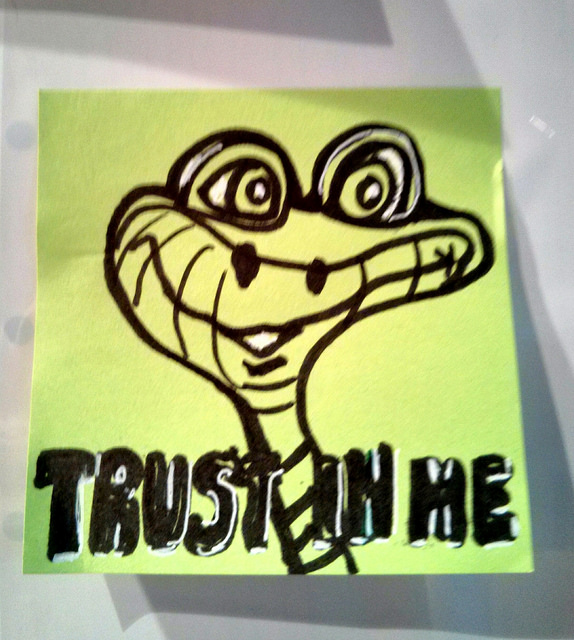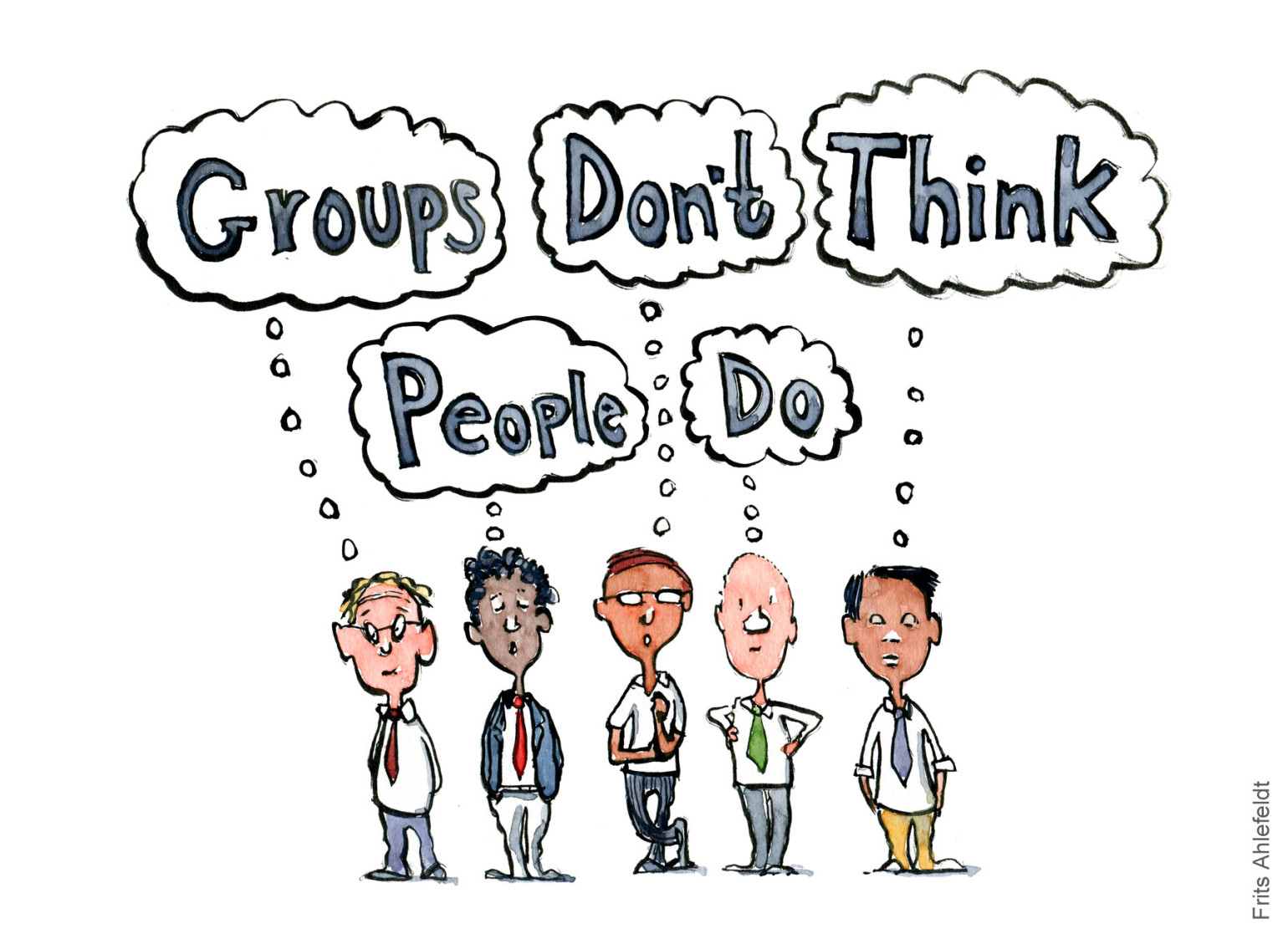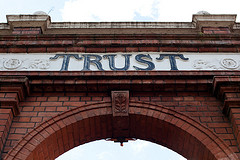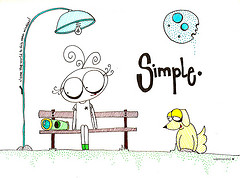|
|
|
Monday, February 11th, 2019

Poking through 12+ years of posts I find information that’s as useful now as when it was written.
Golden Oldies is a collection of the most relevant and timeless posts during that time.
Trust is a funny thing. We don’t usually ask ourselves if we trust someone when we initially meet. Often, the only reason we start thinking consciously about whether we trust them is because some action of theirs felt untrustworthy. We may not even be able to identify what it was; just a niggling discomfort that makes us squirm a bit.
We would all be wise to pay attention to the niggle.
Although too often we blow it off and go our merry way.
Read other Golden Oldies here.
No matter the medium you use to follow the news a large proportion of the stories have a trust angle—most with a negative look at who/how/why it was broken.
I tend to trust people with good diction because I can hear what they say; others trust people because of perceived commonality—the same place of worship, similar political stances, the same schools, military service, mutual connections, etc.
When you see it written down like that the idiocy of any commonality as a basis for trust is apparent, but on any day you can find stories about broken trust that was based on these and similar ephemeral reasons (such as diction). Possibly one of the dumbest is the trust based on some form of online friendship at places such as Facebook.
Even trust in introductions made by long time friends can be misplaced as the experience of my friend Kelly shows.
Briefly, her friend arranged a blind date for Kelly with a guy she knew. She didn’t mention that she had only chatted for a few minutes with him during a conference; she thought he was cute and that Kelly would like him.
Fortunately for Kelly he was arrested two days before their date—charged with attempted rape. Her friend was shocked because he was well dressed and it was a professional conference, so she assumed he was OK.
There are thousands of similar stories out there; many with much worse endings.
So how do you know who to trust?
When I was looking for quotes about trust for yesterday’s post I found an anonymous one that offers some excellent guidance.
“The key is to get to know people and trust them to be who they are. Instead, we trust people to be who we want them to be- and when they’re not, we cry.”
Getting to know someone takes time, but you can pursue a dual track by giving the people the benefit of the doubt if your guts says yes, while maintaining a vigilant watch to make sure that their actions are consistent with their expressed MAP (mindset, attitude, philosophy™) and being ruthless in not rationalizing away the inconsistencies.
Image credit: Vic
Posted in Golden Oldies, Personal Growth | No Comments »
Wednesday, October 31st, 2018

I ended a post a couple of weeks ago by asking “when will they ever learn” and answering my own question with “never.”
“They” referred to the millions of people who continue to rely on Google, Facebook, Amazon, etc. — in spite of every security breech, hack, lie, prevarication, hedge, and excuse — not to mention buying all kinds of smart devices.
So what’s new?
What’s new is that Google won (conned) the right to teach kids how to behave online.
The tech giant is positioning itself in schools as a trusted authority on digital citizenship…
That is the message behind “Be Internet Awesome,” a so-called digital-citizenship education program that the technology giant developed for schools. (…) Google plans to reach five million schoolchildren with the program this year and has teamed up with the National Parent Teacher Association to offer related workshops to parents.
Impressive, considering that historically the NPTA has been dominantly female (although they’re working to change that) and Google is the company that not only protects high ranking abusers, but pays them millions.
Mr. [Andy] Rubin was one of three executives that Google protected over the past decade after they were accused of sexual misconduct. In two instances, it ousted senior executives, but softened the blow by paying them millions of dollars as they departed, even though it had no legal obligation to do so. In a third, the executive remained in a highly compensated post at the company. Each time Google stayed silent about the accusations against the men.
The spying, listening and other sneaky actions of Google Assistant and Alexa are legion and now Facebook joins the herd, with a new in-home device equipped with microphones and a video camera that can really sell you.
“Portal voice calling is built on the Messenger infrastructure, so when you make a video call on Portal, we collect the same types of information (i.e. usage data such as length of calls, frequency of calls) that we collect on other Messenger-enabled devices. We may use this information to inform the ads we show you across our platforms. Other general usage data, such as aggregate usage of apps, etc., may also feed into the information that we use to serve ads,” a spokesperson said in an email to Recode.
You can bet people will buy it.
Alexa has a particularly creepy approach.
Amazon has submitted a patent application, recently granted, outlining how the company could recommend chicken soup or cough drops to people who use its Echo device if it detects symptoms like coughing and sniffling when they speak to it, according to a report by CNET. It could even suggest a visit to the movies after discerning boredom. Other patents submitted by the company have focused on how it could suggest products to people based on keywords in their conversations.
And, if you have one in the bedroom, just think what Echo could suggest based on what it hears.
Most smart devices cater to “what’s in it for me,” with little concern for their users.
However, some work a bit more for the public good, such as Kinsa smart thermometers, which has a public health focus.
“What this does is help us really target vulnerable populations where we have a clear signal about outbreaks,” Mr. Sarma said.
Mr. Singh, who was an executive vice president at the Clinton Health Access Initiative, said that Kinsa worked only with clients that can help with its mission of preventing the spread of illness through early detection. It made sense to work with Clorox, he said, because of the C.D.C. recommendation about disinfecting.
Since it’s Halloween, we’ll end with a truly terrifying look at Facebook in the detailed review of The Autocracy App by Jacob Weisberg
When will they ever learn?
As every link in this post proves…
Never.
Image credit: Paul Downey
Posted in Culture, Ethics, Innovation | No Comments »
Thursday, September 13th, 2018

I have been exploring a few options lately when it comes to my career. While I am not unhappy with my current role I realize that the potential elsewhere is greater.
This has led to some interesting thoughts as I look into different companies and teams. It is almost like a career day at school, you sit there to hear about different paths and imagine yourself in the role.
I read an article one time that stated its hard for a company to convey culture during the interview process, instead, they lead with salary and benefits.
This makes sense to a degree, but as a candidate, you end up dealing with asymmetric information. Sure there are sites that give job reviews but we all know that when you really dislike a job you will write a review. Lukewarm about the whole thing? Probably not writing a review one way or the other. So how can we overcome this information gap?
As I have matured a bit in my career (mature is loosely defined, by the way) I have started resorting to reaching out to a trusted friend or business acquaintance. I like to hear about their personal experiences and their viewpoints.
One way I do this is by reaching out to those I respect via LinkedIn or on the phone. I prefer hearing someone describe something and listen to their tone while they say it.
Why do I do this? If I trust someone then I feel that they will have my best interests in mind.
If I reach out to a random site online that have company reviews, then I really do not know if they have my best interests in mind. They could be bitter or they could just have an employer encouraging positive reviews.
How do you evaluate?
Image credit: Hiking Artist
Posted in Culture, Hiring, Personal Growth, Ryan's Journal | No Comments »
Wednesday, August 1st, 2018

Empowering people is something every good boss, from CEO to team leader, wants to do.
Sometimes that can be accomplished by making a small change that turns out to have a giant impact, as GM Chairman/CEO Mary Barra found when she became vice president of global human resources in 2009.
Barra wanted to change GM’s 10-page dress code to a simple, two-word one, ‘dress appropriately.’
Her staff didn’t agree.
But the HR department ironically posed my first hurdle. They started arguing with me, saying, it can be ‘dress appropriately’ on the surface, but in the employee manual it needs to be a lot more detailed. They put in specifics, like, ‘Don’t wear T-shirts that say inappropriate things, or statements that could be misinterpreted.’”
The kind of detailed instructions the hr staff wanted to add may not seem like that big a deal, but the underlying implication is that the company didn’t trust them. Remove the details and you have a radically different result.
“But if you let people own policies themselves—especially at the first level of people supervision—it helps develop them. It was an eye-opening experience, but I now know that these small little things changed our culture powerfully. They weren’t the only factor, but they contributed significantly.” (…) By simply stating “dress appropriately,” Barra does exactly what she asks of other leaders: She avoids assumptions, instead choosing to trust her employees’ judgment—and has found the experience remarkably liberating.
Not to mention successful.
If that attitude works in a company with 180,000 employees it will probably work for you.
Image credit: Wikipedia
Posted in Change, Communication, Culture, Role Models | No Comments »
Monday, January 22nd, 2018
Poking through 11+ years of posts I find information that’s as useful now as when it was written.
Golden Oldies is a collection of the most relevant and timeless posts during that time.
There are two lessons in this post.
The first is that managing at any level requires you to be present, conscious, and focused on your people — not on your social media, where you’re having dinner, or the work being done on your home.
The second, is that if you are one of the truly bad ones, who messes with your people’s heads and inflicts intentional hurt on them, you will get yours, because eventually what goes around does come around — no matter how long it takes.
Read other Golden Oldies here.

“Is there a single devastating thing I may do unconsciously that messes my people up the most and, if so, what are the effects?”
I’ve heard variations of this question from many managers over the years.
The answer is yes, there sure is and if you aren’t doing it unconsciously then you’re one of the really bad guys and I can only hope that your turnover soars and your reputation spreads.
The action is inconsistency and the primary effect is fear. Secondary effects include intimidation and insecurity.
The end results in the business world are distrust, low productivity, less innovation, abysmal retention and, on a more personal level, poor reviews, fewer promotions and less opportunity.
It doesn’t matter that the inconsistency is unintentional, arbitrary or whimsical the results are the same.
It’s not knowing that really gets to people—even more than expected abuse.
Think about it. It’s one thing to have someone who constantly criticizes (unconstructively) or disparages you, because you can learn how to turn a deaf ear if, for some reason, you can’t get out of earshot.
But when a zinger comes out of nowhere in what’s normally constructive, or at least neutral, feedback you’re caught unaware, thrown off balance and it really gets to you.
Actually, the more infrequent it is the worse it is when it does happen. And after it happens a few times people find themselves waiting for it, wondering when it’ll happen again and almost holding their breath to see if this is the time the other shoe will drop.
That fear grows exponentially once it takes root and distrust typically increases at the same rate.
Can you think of a worse scenario for people to labor under?
But when it’s unconscious, how do you know?
If you actually focus on the person with whom you’re talking, instead of checking your phone or thinking about something else, you’ll see the zinger hit and you should be able to identify what it was. If you can’t, then ask! Acknowledge the reaction, state that you know it was something you said, but you’re not sure what. Be gentle if you expect the person to open up, but you stand a better chance if you ask immediately, while they’re still in shock.
But if you did it on purpose, to enjoy the show and then get them to open up so you can twist the knife, I sincerely hope that all your teeth and hair fall out and Zeus’ thunderbolt strikes you where you stand and chars you into tiny little bits.
Image credit: sxc.hu
Posted in Communication, Golden Oldies, Motivation, Retention | No Comments »
Friday, January 19th, 2018

A Friday series exploring Startups and the people who make them go. Read all If the Shoe Fits posts here.
Sometimes predictions are hilarious, especially those about where technology is taking us.
It’s not that they get the tech wrong, but they often don’t factor in the minor details — such as customers.
Media is aglow with stories of how autonomous vehicles (AVs) will literally change the world beyond anything you can imagine.
In a recent survey by AAA, for example, 78% of respondents said they were afraid to ride in an AV. In a poll by insurance giant AIG, 41% didn’t want to share the road with driverless cars. And, ironically, even as companies roll out more capable semi-AVs, the public is becoming less—not more—trusting of AVs, according to surveys over the past 2 years by the Massachusetts Institute of Technology (MIT) in Cambridge and marketing firm J.D. Power and Associates.
And then there’s security.
Every time a software hack is reported, especially from a vulnerability the company knew about two years before it happened, as with Chrysler’s Jeep, or a bank, a retailer, a whatever, people grow more and more aware of just how vulnerable a software-based world that runs on online updates actually is.
Speaking at the National Governors Association meeting last year, Tesla’s Elon Musk, said, “I think one of the biggest concerns for autonomous vehicles is somebody achieving a fleet-wide hack.”
The solution?
Mr Musk insists that a kill switch “that no amount of software can override” would “ensure that you gain control of the vehicle and cut the link to the servers”,
But what does control mean to an inert lump of metal that has no gas pedal, brakes, or steering wheel?
The car would just shut down wherever it was — maybe the middle of the freeway at rush hour or a lonely mountain road during a storm.
So customer trust and security are the main obstacles to the AV/tech-enabled world companies large and small are drooling over.
Given most companies historically cavalier attitude towards security and the general distrust of auto companies in particular, the result of multiple recalls over the years, changing people’s minds won’t be easy.
And for every step forward a major hack will mean at least three steps back.
Image credit: HikingArtist
Posted in If the Shoe Fits, Innovation | No Comments »
Tuesday, October 24th, 2017
Today’s and tomorrow’s posts are follow-ups to last Monday’s, before the site was hacked.
Trust is the most important component in company culture. Without trust the culture is hollow — a sham that people will quickly see through. Trust has nothing to do with words, whether spoken or printed on a poster and hung on the wall. Wally Bock wrote what I consider the most insightful explanation of trust I’ve read, so I thought I’d share it with you. (And I highly recommend Wally’s e-book; there’s a link at the end.)
It’s also good to remember that trust doesn’t just apply to individuals, but also to entire companies. As Google is learning, losing customer trust is even more devastating and can morph into long-term consequences very quickly.
 The Burlington Industries building used to stand on a large plot of ground near where I lived in Greensboro, NC. The campus was adorned with wonderful oak trees whose thick trunks attested to how long they had been there. The Burlington Industries building used to stand on a large plot of ground near where I lived in Greensboro, NC. The campus was adorned with wonderful oak trees whose thick trunks attested to how long they had been there.
But the company came on hard times. First the building was emptied. It sat on the beautiful campus until demolition company explosions brought it down while rattling windows all around and setting the local dogs to barking.
Work crews moved in immediately. They hauled away the remains of the building. They bulldozed the area flat. And, finally, they took the trees.
One day as I drove home, I noticed that it seemed much lighter than usual. Then I realized why. In the place of old oak trees with thick trunks there were only stumps.
While many alumni of Burlington Industries loved the building, it was just an artifact. The trees were living things and when the chain saws took them, the entire area changed.
Leaders build trust slowly, through good times and bad, the way a tree grows. It happens gradually, almost imperceptibly.
But the trust built over years and decades can disappear in an instant. The chainsaws of betrayal or selfishness or greed can destroy what it took ages to grow.
Like trees, the trust your people have in you grows slowly. Despite the common phrase, you don’t build trust at all, you grow it. And you grow it slowly.
Trust grows from kept promises, from actions that demonstrate concern for your people as well as the mission, and from fairness and from consistency.
Like trees, trust is more fragile in the beginning. It takes time for the trunk to grow thick and the roots to go deep so the tree can weather big storms. But even big trees can be brought down, like those wonderful oaks on the Burlington Industries campus in Greensboro. When that happens, everything changes.
Trust is one of the most valuable things you have as a leader. Make the effort and take the time to grow it. Be wary of anything that can bring it down.
Resource
The 347 tips in my ebook can help you Become a Better Boss One Tip at a Time.
I would add that trust is one of the most valuable things you have as a human in any role.
Image credit: Wally Bock
Posted in Culture, Leadership, Personal Growth, Retention | No Comments »
Monday, September 22nd, 2014

Does your company have soul?
Or is it so focused on profit that there is no room for anything else?
What does it mean for a company to have soul?
That question is addressed by a Belgium, Frederic Laloux, who quit McKinsey when he found himself miserable and out of touch with his clients.
“The work I had loved so much was work I simply couldn’t do any longer. I came to the realization that I was in a very different place than the executive teams of the large corporations with whom I had been working. I just couldn’t work with these big organizations anymore. They felt too soulless and unhealthy to me, too trapped in a rat race of just trying to eke out more profits.”
Wondering what gave a company soul fueled two years of research that resulted in Reinventing Organizations: A Guide to Creating Organizations Inspired by the Next Stage of Human Consciousness.
Not surprisingly, Laloux found that trust ranked at the top of managerial attitudes that create soul.
Trust, Mr. Laloux found, is perhaps the most powerful common denominator in the companies he studied. “If you view people with mistrust and subject them to all sorts of controls, rules and punishments,” he writes, “they will try to game the system, and you will feel your thinking is validated. Meet people with practices based on trust, and they will return your trust with responsible behavior. Again, you will feel your assumptions were validated.”
In other words, bosses (like most others) get what they expect.
While trust can’t be faked, it is trust a function of individual bosses, from the most junior all the way up to the CEO.
That means that even if you are working in a soulless situation you can run your own organization with trust, integrity and soul.
Flickr image credit: Lars Plougmann
Posted in Culture, Personal Growth, Reviews & Recommendations | No Comments »
Tuesday, July 17th, 2012
“To the extent that creativity is about the recombination of existing ideas, then combining ideas that haven’t been connected before creates the potential to produce something new and useful.” –Roy Chua, assistant professor in the Organizational Behavior unit at Harvard Business School.
Chua is talking about the importance of collaborating creatively with people from other cultures.
Research finds that innovation only results when there is a high level of affective trust.
…”cognitive trust,” an intellectual appreciation of another person’s skills, abilities, and reliability; and “affective trust,” an emotional belief that another person has one’s best interests at heart.
I have no research to back this up, but I bet affective trust is just as important to people with the same cultural background, but other differences, such as gender.
Over the decades I’ve talked with thousands of people and none of them were willing to take a risk or show their vulnerabilities to someone they didn’t trust, whether boss, colleague or spouse.
Finding ways to measure and improve affective trust in your organization will provide a sound foundation for creating a culture of innovation.
Flickr image credit: PhillipC
Posted in Culture, Ducks In A Row, Innovation | 1 Comment »
Monday, August 16th, 2010

No matter the medium you use to follow the news a large proportion of the stories have a trust angle—most with a negative look at who/how/why it was broken.
I tend to trust people with good diction because I can hear what they say; others trust people because of perceived commonality—the same place of worship, similar political stances, the same schools, military service, mutual connections, etc.
When you see it written down like that the idiocy of any commonality as a basis for trust is apparent, but on any day you can find stories about broken trust that was based on these and similar ephemeral reasons (such as diction). Possibly one of the dumbest is the trust based on some form of online friendship at places such as Facebook.
Even trust in introductions made by long time friends can be misplaced as the experience of my friend Kelly shows. Briefly, her friend arranged a blind date for Kelly with a guy she knew. She didn’t mention that she had only chatted for a few minutes with him during a conference; she thought he was cute and that Kelly would like him. Fortunately for Kelly he was arrested two days before their date—charged with attempted rape. Her friend was shocked because he was well dressed and it was a professional conference, so she assumed he was OK.
There are thousands of similar stories out there; many with much worse endings.
So how do you know who to trust?
When I was looking for quotes about trust for yesterday’s post I found an anonymous one that offers some excellent guidance.
“The key is to get to know people and trust them to be who they are. Instead, we trust people to be who we want them to be- and when they’re not, we cry.”
Getting to know someone takes time, but you can pursue a dual track by giving the people the benefit of the doubt if your guts says yes, while maintaining a vigilant watch to make sure that their actions are consistent with their expressed MAP (mindset, attitude, philosophy™) and being ruthless in not rationalizing away the inconsistencies.
Image credit: http://www.flickr.com/photos/saposaraso/4735101694/
Posted in Personal Growth | No Comments »
|
 Subscribe to
Subscribe to
MAPping Company Success
About Miki 
Clarify your exec summary, website, etc.
Have a quick question or just want to chat? Feel free to write or call me at 360.335.8054
The 12 Ingredients of a Fillable Req
CheatSheet for InterviewERS
CheatSheet for InterviewEEs™
Give your mind a rest. Here are 4 quick ways to get rid of kinks, break a logjam or juice your creativity!
Creative mousing
Bubblewrap!
Animal innovation
Brain teaser
The latest disaster is here at home; donate to the East Coast recovery efforts now!
Text REDCROSS to 90999 to make a $10 donation or call 00.733.2767. $10 really really does make a difference and you'll never miss it.
And always donate what you can whenever you can
The following accept cash and in-kind donations: Doctors Without Borders, UNICEF, Red Cross, World Food Program, Save the Children
*/
?>About Miki
About KG
Clarify your exec summary, website, marketing collateral, etc.
Have a question or just want to chat @ no cost? Feel free to write
Download useful assistance now.
Entrepreneurs face difficulties that are hard for most people to imagine, let alone understand. You can find anonymous help and connections that do understand at 7 cups of tea.
Crises never end.
$10 really does make a difference and you’ll never miss it,
while $10 a month has exponential power.
Always donate what you can whenever you can.
The following accept cash and in-kind donations:
|










 The Burlington Industries building used to stand on a large plot of ground near where I lived in Greensboro, NC. The campus was adorned with wonderful oak trees whose thick trunks attested to how long they had been there.
The Burlington Industries building used to stand on a large plot of ground near where I lived in Greensboro, NC. The campus was adorned with wonderful oak trees whose thick trunks attested to how long they had been there.



